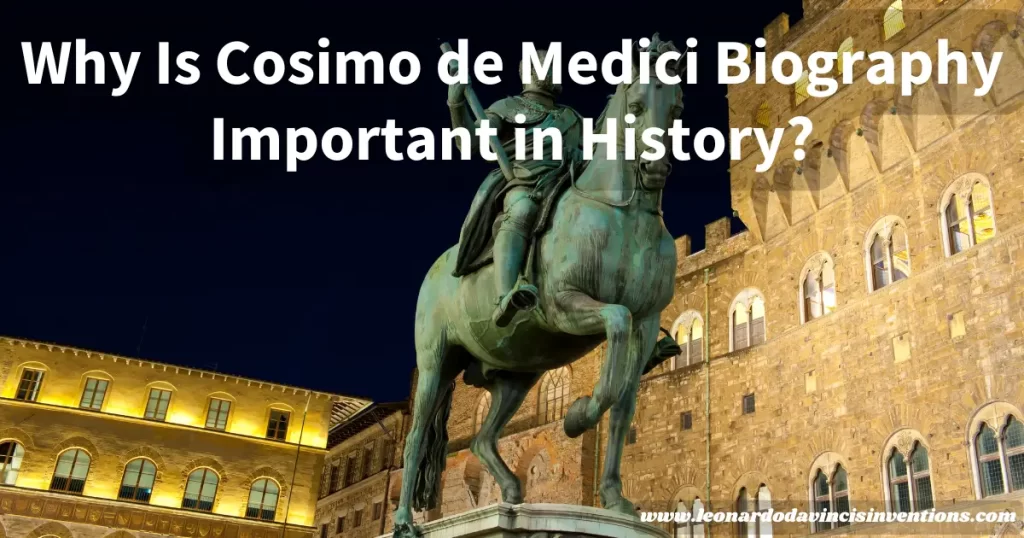
Cosimo de’ Medici biography offers a closer look at one of the most influential figures in the Italian Renaissance. Many people overlook his story, but it shaped the world you know today.
Understanding Cosimo’s life and legacy is essential if you have ever wondered how Florence became a center of art, culture, and power.
Cosimo de’ Medici’s biography is important in history because he utilized his wealth and leadership to promote the arts, learning, and architecture, laying the foundation for the Renaissance in Florence.
Through his support for artists and thinkers, Cosimo changed the future of Europe and inspired generations. Exploring Cosimo’s life reveals how one person helped spark a cultural movement that still matters today.
The Rise of Cosimo de’ Medici and the Medici Family in Florence
Cosimo de’ Medici’s path to power changed the future of Florence and the wider Italian Renaissance. His success came from strong family foundations, financial expertise, and a new style of political leadership that shaped the Medici legacy.
Early Life and Influence of Giovanni de Medici, His Father
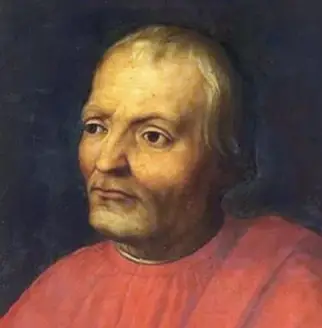
Cosimo de’ Medici was born in 1389 into the influential Medici family. His father, Giovanni de’ Medici, established the Medici Bank in Florence.
This financial institution quickly became one of the most respected banks in Europe. It gained a reputation for reliability and strong connections with the papacy.
Giovanni taught Cosimo the value of trust, careful planning, and support for the economy and the arts. His guidance helped Cosimo understand how money and reputation could shape political power.
Through his example, Giovanni set his son on a path to leadership in both business and society. Giovanni also emphasized philanthropy and supported many Florentine charities.
This created goodwill and loyalty toward the Medici family in the city. These early lessons prepared Cosimo to take over the family fortune and expand their political and economic influence.
Cosimo de’ Medici as the Founder of the Medici Dynasty
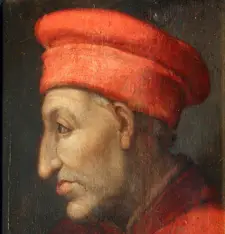
Cosimo de’ Medici is known as the founder of the main branch of the Medici dynasty. After his father’s death, Cosimo took control of the family bank and political strategy, establishing the Medici as leaders of the Florentine Republic.
His careful management helped the family rise without attracting negative attention from rivals. He used his fortune to gain support from influential families, bankers, and politicians.
Cosimo protected the Medici name by helping allies, forgiving debts, and mediating during unrest. His approach allowed the Medici to exert real influence even when they did not officially hold public office.
Cosimo built a network of loyal supporters and became Florence’s effective ruler, or “uncrowned monarch,”. He set the stage for later generations to continue the Medici rule well into the 16th century.
The Medici Banking Empire and Italian Banking Family Power
The Medici Bank under Cosimo’s control became a financial powerhouse. The Medici gained enormous wealth and political leverage by managing accounts for the Catholic Church and wealthy European merchants.
Their bank set standards in bookkeeping, lending, and partnerships that other banking families attempted to emulate. A simple table shows areas in which the Medici Bank excelled:
| Area | Medici Bank Achievements |
|---|---|
| Papal Accounts | Managed finances for the Vatican |
| Lending | Offered credit to monarchs and traders |
| Innovation | Used double-entry bookkeeping |
Cosimo used banking profits to sponsor arts, building projects, and public events. The banking empire also allowed him to fund political campaigns and maintain friendships across Italy and Europe.
His bank faced challenges from political adversaries and shifting market conditions. Cosimo’s attention to detail and ability to rebuild trust kept the bank strong during difficult times.
Florence Republic and the Political Power of the Medici Family
The Florence Republic often came under the influence of powerful families. Cosimo de’ Medici pushed the limits by becoming Florence’s leading political force without formal titles.
He worked behind the scenes, guiding votes, securing alliances, and choosing loyal people for city government positions. Cosimo paid close attention to Florentine politics and controlled key institutions, such as the Signoria.
He utilized his resources to garner public support and keep his opponents in check. Cosimo supported public works and charity, strengthening his position among ordinary citizens.
This made him a respected figure in both politics and daily Florentine life.
Cosimo the Elder’s Role as a Florentine Leader and De Facto Ruler
Cosimo the Elder served as Florence’s de facto ruler from 1434 until he died in 1464. Even though Florence was a republic, Cosimo handled many decisions that were usually left to official leaders.
He shaped policies about trade, city planning, and taxes, ensuring stability and growth. Cosimo lived much of his life at Careggi, a villa he made into a center for scholars and artists.
His patronage of architecture and art brought new energy to the Renaissance. Under his leadership, Florence witnessed the emergence of new buildings, sculptures, and paintings that would inspire later generations.
His balanced rule earned him the title “Pater Patriae,” or Father of the Fatherland. Cosimo’s example shaped how the Medici governed for decades, helping Florence become one of Europe’s most important centers for trade, culture, and art.
Cosimo de’ Medici’s Impact on Renaissance Culture and Art Patronage
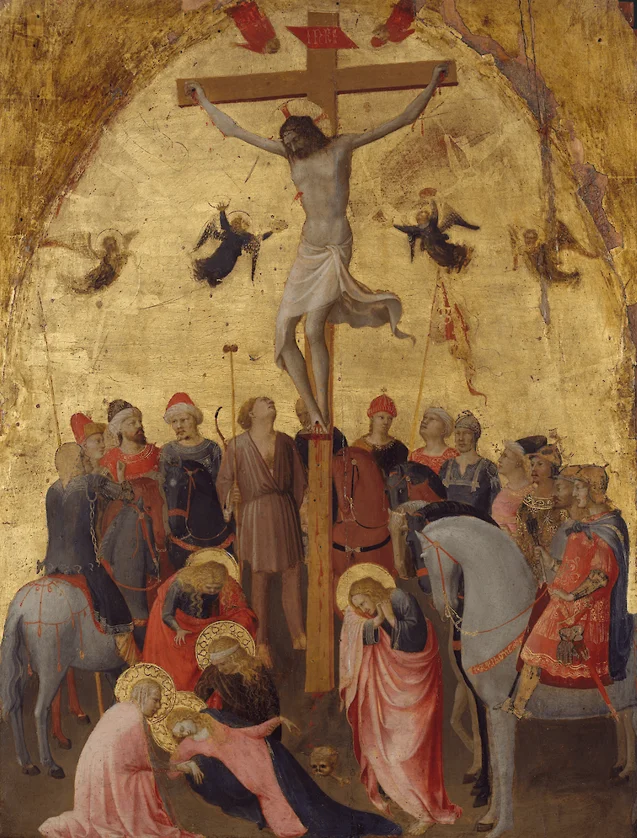
In the 15th century, Cosimo de’ Medici strengthened Florence’s reputation as a center for culture, art, and learning.
He reshaped the city’s society and identity through cultural investments, political power, and the establishment of legacy-building institutions.
Patron of the Arts: Medici Patronage of Artists and Renaissance Art
As a prominent Patron of the Arts, Cosimo de’ Medici fueled the rise of Renaissance art in Florence. He used the wealth of the Medici banking empire to commission works from artists such as Donatello, Fra Angelico, and Brunelleschi.
His support was practical, providing artists with financial stability so they could focus on developing new techniques and ideas. Art patronage under Cosimo the Elder set trends across Italy, encouraging more nobles to support artists.
He championed humanism and the study of classical works, which influenced the styles and subjects of artists. These practices laid the foundation for later achievements in Renaissance art, helping Florence become a hub of creativity and expression.
Cosimo’s patronage went beyond individual commissions. He sponsored workshops, studios, and the building of churches that became displays of artistic innovation.
Architecture and Art: Careggi’s Villa as a Cultural Symbol
Careggi, Cosimo de’ Medici’s villa outside Florence, symbolized Renaissance architecture and culture. He transformed this country house into a gathering place for scholars, artists, and thinkers.
The villa’s design, influenced by classical Roman architecture, reflected the new Renaissance ideals of beauty, order, and balance. Careggi was not just a private home; it hosted the Platonic Academy, where leading humanists held regular meetings.
These gatherings promoted discussion on philosophy, art, and science. By fostering intellectual exchange, Cosimo tied his identity as a Florentine leader to culture and learning, setting a standard for Italian elites.
The villa’s art, gardens, and architecture reflected Medici values and taste. Careggi became a model that other powerful families emulated, using architecture to showcase their status and contribute to the city’s cultural life.
Medici Contributions to Florence’s Cultural Influence and Society
The Medici contributions to Florence’s reputation as a center for art, banking, and diplomacy were substantial. Cosimo de’ Medici shaped public projects through his wealth in banking and political influence.
He funded libraries, built churches such as San Lorenzo, and helped establish institutions that promoted literacy and learning. His steady political leadership helped Florence stay stable during difficult times.
Cosimo’s support for civic festivals, libraries, and scholars raised the city’s profile across Europe. The Medici legacy also included efforts to blend new Renaissance ideas with Florence’s traditions.
His impact transformed daily life in Florence, creating a society where artists, scholars, and citizens could thrive together.
The Medici Family’s Role in Shaping the Italian Renaissance
The Medici family used a unique blend of economic power and cultural sponsorship to shape the Italian Renaissance. Cosimo, as the de facto ruler or “uncrowned monarch,” led the House of Medici’s rise to financial and political dominance.
Their ownership of a banking dynasty allowed them to offer critical loans to monarchs and the Church. Medici governance built alliances with artists and intellectuals, making Florence a magnet for talent.
The family’s political strategy relied on supporting both religious and secular projects, reinforcing their rule. Their influence helped new ideas spread throughout Italy.
The Medici dynasty’s network extended beyond Florence. Their connections promoted Italian art and culture across Europe, making their impact broader and more lasting than that of most other Florentine families.
Medici Cultural Legacy and Its Lasting Historical Impact
The Medici cultural legacy is still visible in Florence today. Buildings, art collections, and public works from Cosimo’s era remain central to the city’s character.
Cosimo de’ Medici’s decisions established patterns for rulers who sponsored the arts and learning for the public good, as well as their private prestige. Medici heirs continued his tradition, supporting artists like Michelangelo and Leonardo da Vinci.
The idea of the politician as a cultural leader became a model across Europe. Museums, universities, and churches associated with the Medici family are landmarks of world history.
Cosimo’s mix of political power, art patronage, and banking shaped European society. His legacy as a founder of the Renaissance stands out in the biography of Cosimo de’ Medici and others, shaped by his vision.
Political Strategy, Governance, and the Enduring Medici Legacy
Cosimo de’ Medici shaped Florence through careful political moves, economic strength, and long-term planning. His actions laid the foundation for the Medici family’s ongoing cultural, political, and economic dominance during the Renaissance.
Cosimo de Medici’s Political Strategy and Governance of Florence
Cosimo de’ Medici, known as Cosimo the Elder, leveraged his banking success to become a highly influential figure in Florence. As an experienced banker and politician, he gained influence quietly by forming alliances with other wealthy families and supporting both the common people and the elites.
He avoided official titles and ruled as an uncrowned monarch by placing loyalists in key government roles. He invested in the city’s infrastructure, arts, and education.
Cosimo balanced generosity with caution. He avoided appearing too ambitious, which kept opposition groups weak.
This approach made him a trusted leader among citizens and allowed the Medici family to grow stronger behind the scenes.
Medici Rule and the Establishment of a Political Dynasty
Under Cosimo’s guidance, the Medici family transformed from a successful banking dynasty into a lasting political one. Their control of Florence depended on their wealth and a broad network of personal connections.
Cosimo united family interests with city government, making the Medici essential to Florence’s well-being. Marriage alliances, clear lines of succession, and cultivation of allies helped power pass smoothly within the Medici house.
The Medici dynasty continued to produce influential leaders long after Cosimo’s death, such as his grandson Lorenzo de Medici. These heirs kept the family’s power intact and strengthened Medici rule over Florence for generations.
Influence on Florentine Politics and Medici Family Power
Cosimo de’ Medici’s control significantly influenced many aspects of Florentine politics. As de facto ruler, he influenced laws and policies without any official title.
He used his economic resources to reward supporters and win loyalty from citizens and politicians. Public works projects, patronage of the arts, and investment in public festivals improved the city and secured popular opinion.
Cosimo’s steady leadership made Florence a center of the Italian Renaissance. The family’s continuing cultural influence strengthened their legitimacy and political power.
Medici Heirs, Medici Lineage, and the Continuation of Medici Wealth
Starting with Giovanni de Medici and strengthened by Cosimo, the Medici family used business expertise to build a vast banking empire. This wealth funded political activity, art sponsorship, and charitable works.
Medici heirs inherited money and strong connections to rulers, artists, and religious leaders. The careful management of the Medici wealth and banking empire helped later generations survive political setbacks and remain influential.
The family’s art collections, architectural projects, and landholdings became symbols of both financial power and cultural achievement. These assets secured the Medici legacy for centuries.
The Historical Impact of Cosimo de Medici’s Biography on Modern Understanding
Biographies of Cosimo de Medici help explain the rise of modern political and economic systems during the Renaissance. His life shows how finance, family, and politics shaped an era.
Cosimo’s focus on patronage illustrates the connection between private wealth and public benefit in cultural development. His impact on architecture, art, and learning highlights how individuals can guide the direction of cities and countries.
The Medici family story remains a key part of modern studies on leadership and legacy. It also explains the forces behind Florence’s rise as a center of Renaissance art and culture.
Frequently Asked Questions
Cosimo de Medici was a powerful Florentine banker whose actions helped shape the Renaissance era in Italy. Politics, art patronage, family legacy, religious ties, and personal challenges marked his life.
What are 5 facts about Cosimo de’ Medici?
Cosimo de’ Medici, born in 1389, led the Medici family, which ruled Florence for over a century. He was a wealthy banker and a major supporter of the arts and architecture.
Cosimo introduced Ancient Greek manuscripts into Italy, helping to boost humanism. He lived simply despite his wealth, and his leadership made Florence a Renaissance center.
What happened to Cosimo Medici?
Cosimo de’ Medici died in 1464. He lived through political ups and downs, including a temporary exile from Florence.
After returning, he regained his power and influence. He is remembered for his strong impact on Florence and the rise of the Medici family.
Why is Cosimo considered the godfather of Florence?
Cosimo de’ Medici played a significant role in making Florence the heart of the Italian Renaissance. He utilized his wealth and influence to shape city politics and safeguard Florence’s independence.
His ability to lead from behind the scenes earned him a reputation as the “godfather” of Florence’s political and cultural revival.
What did Cosimo de Medici do with his money?
He used his wealth to fund building projects, support scholars, and sponsor artists. Cosimo invested in churches, libraries, and palaces, making Florence a more beautiful and educated.
He was a dedicated patron of the arts, learning, and architecture.
What illness did Cosimo Medici have?
Cosimo de’ Medici suffered from gout later in life. This illness caused him pain and limited his movement, but it did not stop his involvement in public affairs.
Who inherited the Medicis’ wealth?
After Cosimo’s death, his son, Piero de’ Medici, inherited his wealth and leadership role within the Medici family. The family’s power continued through the next generation, especially under Cosimo’s grandson, Lorenzo the Magnificent.
What was Cosimo de Medici accused of?
Cosimo was accused of controlling Florence’s political system for his benefit. Some rivals accused him of bribery and election manipulation.
He was exiled for a year but later returned and regained influence.
What religion was Cosimo de’ Medici?
Cosimo de’ Medici was a Roman Catholic. He supported the Church and gave money to religious causes.
His faith influenced many of his decisions.
What church did Cosimo Medici build?
Cosimo helped fund and build the Church of San Lorenzo in Florence, which became the family’s main place of worship and burial.
It is a landmark of early Renaissance architecture.
Did Cosimo de Medici have an illegitimate child?
Historians believe Cosimo de’ Medici had an illegitimate son named Carlo de’ Medici.
Carlo became a churchman and served as a canon in Florence.
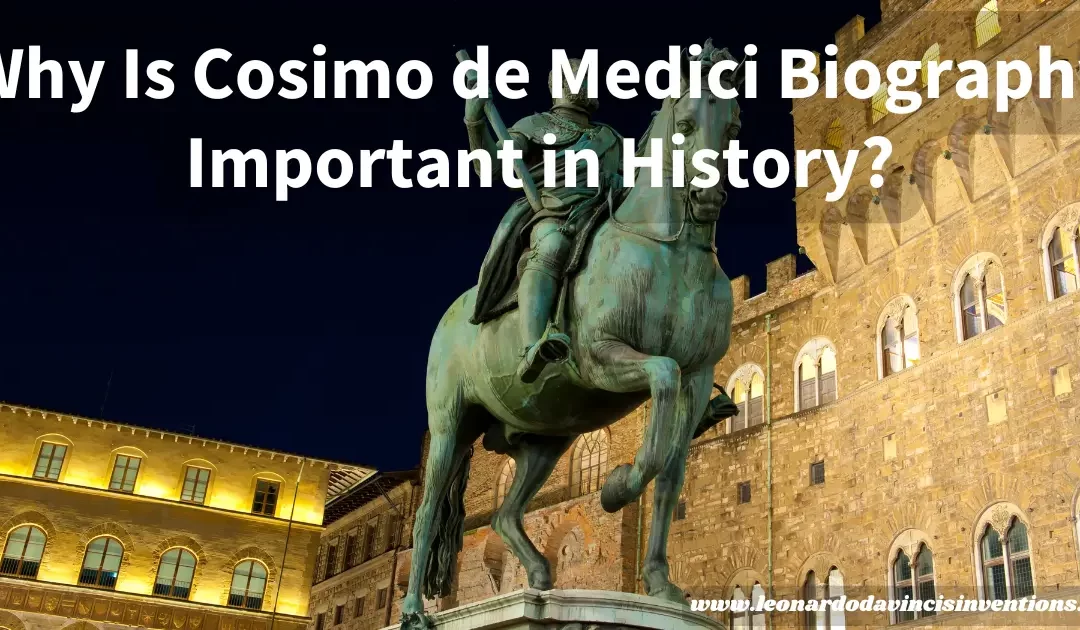
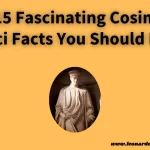
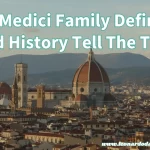
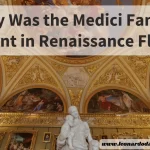
 Leonardo Bianchi,
the creator of Leonardo da Vinci's Inventions.
Thank you for visiting
Leonardo Bianchi,
the creator of Leonardo da Vinci's Inventions.
Thank you for visiting